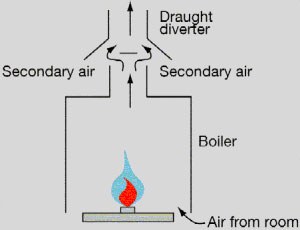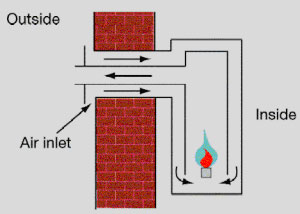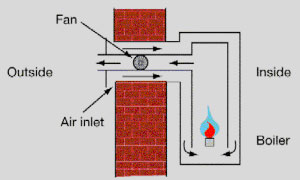Flue Selection
All boilers require a flue to remove their products of combustion. In the past traditional chimney flues restricted where a boiler could be used. Modern boilers have far more flexible flue systems which means there is more choice of where the boiler can be fitted.
Open Flue (Natural Draught)
With a boiler having the type of flue, air for combustion is taken from the room in which the boiler is located. Flue products rise naturally and escape through a vent or chimney. The room must have a route for combustion air direct from outside.

Open Flue Boiler
If there is an extractor fan in the same room as the boiler, then manufacturer’s advice should be sought, since additional ventilation will probably be required to ensure that the boiler flue produsts do not ‘spill’ into the room.
All new open flue boilers must now be fitted with a safety device which will turn the boiler off in the event of flue products spilling back into the room.
Open Flue (Fanned)
Open flue boilers are available wich have a small ‘flue fan’ to help to clear flue products. Exactly the same conditions apply to this type as with natural draught, and it must not be assumed that the requirements for running the flues are any different. The introduction of a fan after the boiler and flue has been fitted does NOT turn this boiler into a fanned flue type.
Room Sealed (Natural Draught)
This boiler draws it sair for combustion directly from outside through the same rectangular flue used to discharge the flue products. This boiler is safer than an ‘open flue’ type, since there is no direct route for flue products to spill back into the room.
This type of boiler can only be fitted to an outside wall.

Room Sealed boiler
Room Sealed (Fanned Flue)
Fanned flue boilers are generally more efficient than other types, since less heat is lost from the small circular flue, whilst at the same time allowing the option of extended flue runs if required.

Room Sealed Fan boiler
Some fanned flue boilers are available with a ‘twin tube’ arrangement, which provides separate connections for the flue pipe and combustion air pipe. This allows longer flue runs than would otherwise be possible.

 Canada
Canada